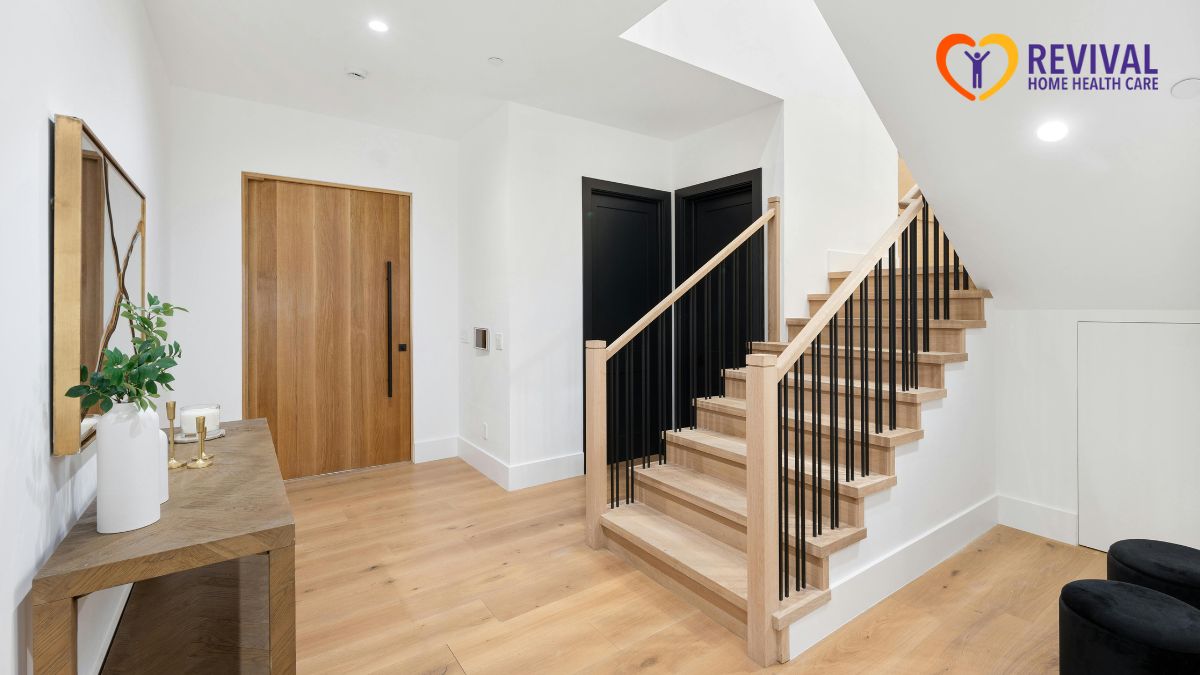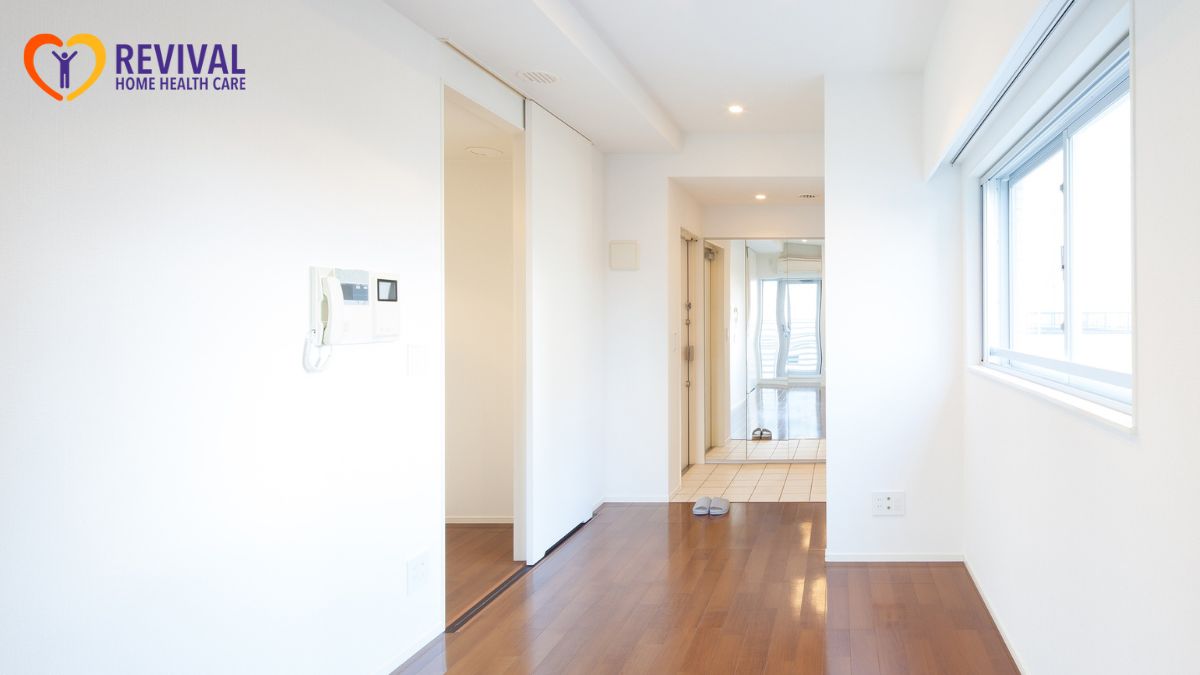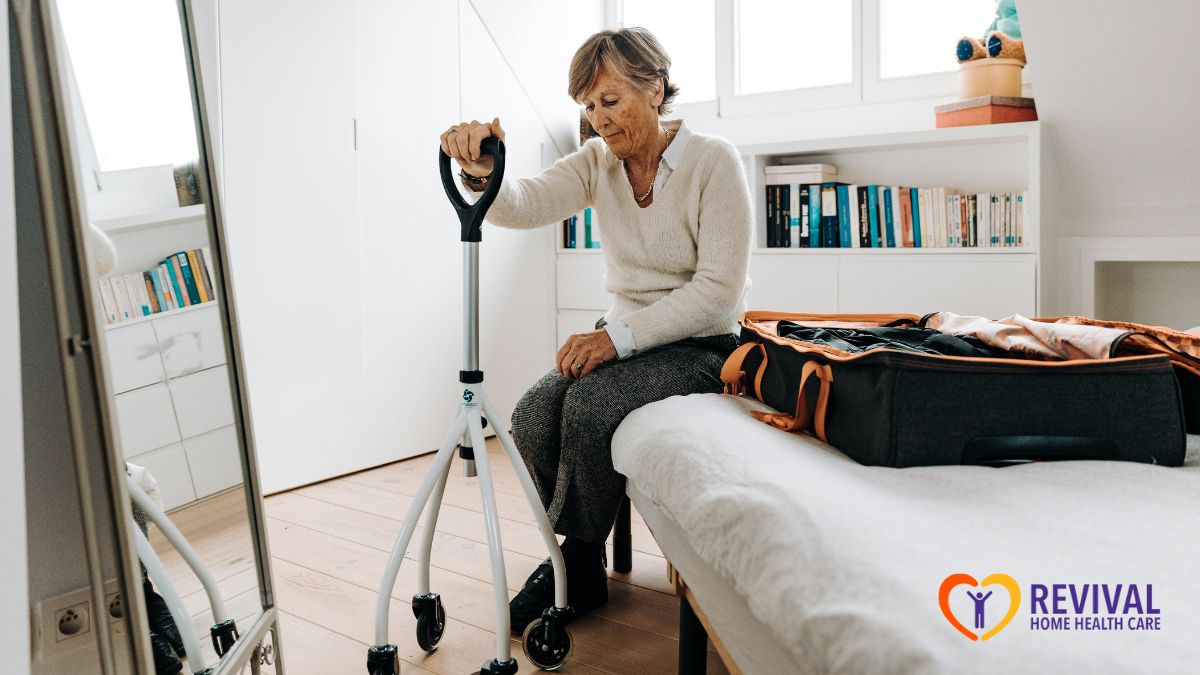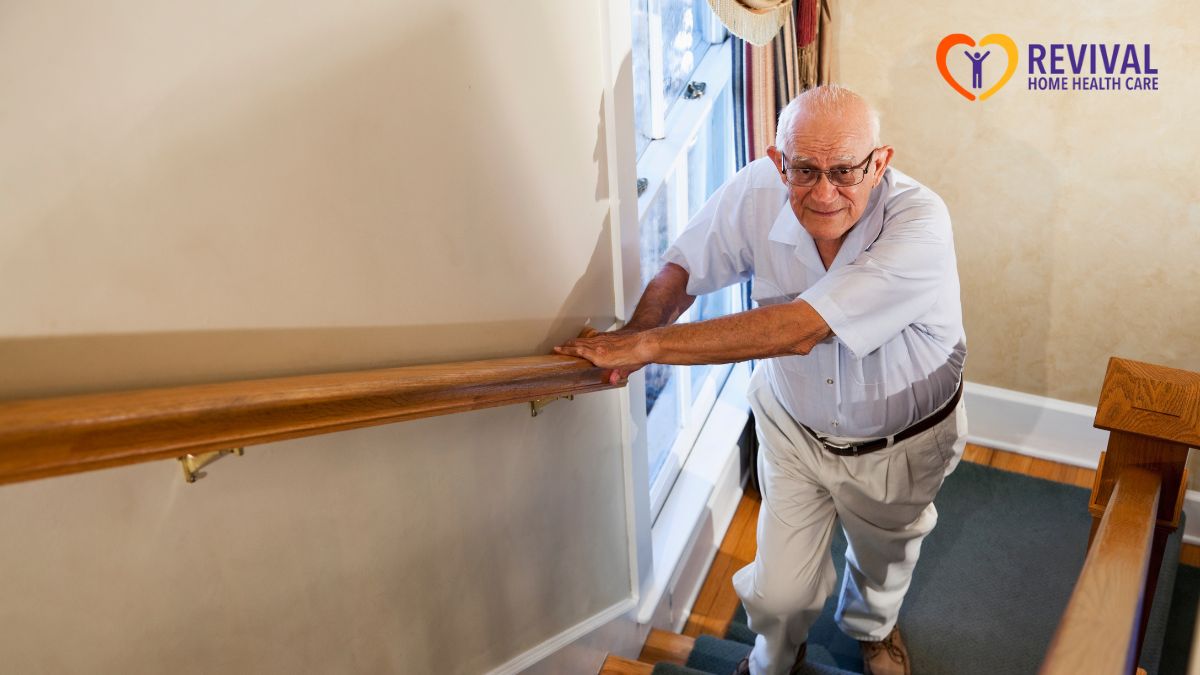Key Points:
- An occupational therapy home safety checklist reviews every room to reduce falls, burns, and medication errors.
- OTs check lighting, flooring, walk paths, and reach zones, then recommend fixes like grab bars, non-slip mats, safe storage, and nightlights.
- The checklist also covers footwear, medication setup, and routines, ending with a prioritized plan for quick improvements.
Falls, burns, and medication mix-ups happen fast at home and often during simple tasks. An occupational therapy home safety checklist gives a clear way to spot risks, make quick fixes, and keep daily life running smoothly.
The plan below explains what the process covers and shows practical changes for each room so you can set up a safer home without guesswork.
 What Is an Occupational Therapy Home Safety Checklist?
What Is an Occupational Therapy Home Safety Checklist?
An occupational therapy home safety checklist is a structured review of the spaces where you cook, bathe, sleep, and move. The goal is simple: remove hazards, support routines, and match the setup to your mobility, vision, strength, and memory needs.
Key areas checked include:
- Entryways, steps, and walkways for safe access
- Transfers in and out of chairs, beds, and showers
- Kitchen setup for reaching shelves and preparing snacks
- Bathroom routines such as bathing and dressing
- Medication storage and daily reminders
- Hazards like cords, clutter, and pets underfoot
The process also lines up with typical insurance and care team needs. Many teams use an occupational therapy home evaluation checklist to standardize what they observe and to track progress over time. And in-home occupational therapy ties these checks to daily tasks.
Small changes often bring quick results. Clear lighting paths, secure seating, and safe storage reduce near misses right away, while the checklist guides future updates as needs change.
How Do OTs Prioritize Fall Risks?
OTs start with the highest-impact risks by applying fall prevention strategies that address tight spaces and transitions. National data shows that about 1 in 4 adults age 65+ falls each year, and many never tell a clinician after the first fall.
Priority fixes in an occupational therapy home safety checklist often include:
- Lighting in entryways, hallways, and bathrooms
- Removing clutter from floors and walkways
- Reviewing footwear to reduce slips
- Addressing transitions between carpet, tile, and other surfaces
The OT will also observe:
- Turning in the bathroom
- Stepping into and out of the tub
- Pivoting in the kitchen during meal prep
The checklist also calls out meds that can cause dizziness. The OT coordinates with the prescriber or pharmacist to plan safer timing or alternatives.
A home evaluation checklist occupational therapy version keeps these steps in order. This sequence reduces risk right away while longer projects move forward.
Bathroom Safety: High-Risk Area, High-Value Fixes
Bathrooms combine water, tight turns, and hard surfaces. The OT looks at approach, transfers, reach, and traction. The aim is to create stable move-in and move-out paths and to control water temperature.
The water heater setting can be a hidden risk. Consumer safety guidance urges users to set the heater to 120°F and notes that exposure to 150°F water can cause a third-degree burn in about two seconds.
Bathroom fixes to consider:
- Install two grab bars at the shower entry and one near the toilet for push and pull support.
- Add a no-slip mat inside and a quick-dry mat outside the shower.
- Set the water heater to 120°F and label the hot handle with high-contrast tape.
- Use a height-adjustable shower chair and a handheld shower to keep both feet planted.
- Choose soap in a pump bottle mounted on the wall to avoid bending or reaching.
- Add motion-activated nightlights on the route from bed to bathroom.
An OT may add a home safety checklist occupational therapy block to map a steady sequence for every bath: lock brakes on a rollator, place the towel within reach, check water first, step in with the stronger leg, and sit fully before washing feet.
Kitchen and Meal Prep: Heat, Reach, and Balance
Kitchen risk grows when you rush, reach too high, or multitask with a phone in hand. An OT watches microwave and oven use, pot handling, knife safety, and the routes between fridge, sink, and stove.
The first goal is to bring often-used items between shoulder and hip height. The second goal is to remove turn-and-twist moves while holding hot or heavy items.
Kitchen fixes to consider:
- Create a “safe zone” triangle with a sturdy counter between the stove and sink to set down hot pans fast.
- Use a lightweight electric kettle with auto shutoff and a cool-touch handle.
- Swap heavy cookware for lighter pans with two handles.
- Keep a silicone trivet on each counter section to set down hot items without thinking.
- Add high-contrast labels to spice jars and medications to avoid mix-ups.
- Store a small fire blanket in an easy-to-reach drawer.
These steps often appear in a home assessment checklist occupational therapy tool that groups tasks by reach, heat, and sharp tools. The OT trains a steady “cook and park” habit to reduce fall risk at home when handling hot or heavy items.
 Bedroom and Hallways: Night Routes and Transfers
Bedroom and Hallways: Night Routes and Transfers
Most nighttime falls start with low light and rushing. The OT walks your route from bed to bathroom and checks for cords, low tables, and rugs with curled edges. The bed height should let your feet land flat with the knees at or just below hip height. A bed rail or sturdy bedside table can give you a safe push surface for the first stand.
Bedroom and hallway fixes to consider:
- Install motion-activated nightlights that trigger as soon as your feet hit the floor.
- Keep a reacher and a sock aid in the nightstand to avoid awkward bends.
- Use a firm, stable chair for dressing rather than sitting on the edge of the bed.
- Replace loose rugs with thin, taped runners that will not bunch.
- Place a charging station away from walk paths and use cord clips to route cables.
The OT rehearses every step until it feels automatic and pairs it with strength and balance work that supports safer night routes. A weekly five-minute “night route check” keeps the space clear after laundry, deliveries, or holiday décor that may creep into the path.
Living Room and Stairs: Seating Height, Clutter, and Rails
Living rooms collect baskets, remotes, footstools, and pet toys that can turn into tripping hazards. The OT checks seating height, arm support, and swivel moves when standing.
On stairs, the focus is on consistent rail support and even lighting, and trained aides reinforce fall prevention habits during daily routines. If you use bifocals, stair edges need high-contrast tape to sharpen depth cues.
Living room and stair fixes to consider:
- Choose chairs with firm seats, armrests, and a seat height near the back of your knees.
- Use remote caddies and a single small table near each seat to reduce clutter.
- Add high-contrast edge tape on stair treads and adequate lighting at top and bottom.
- Install two handrails if the wall allows and keep the same hand on the rail for the full flight.
- Set a “clear the lane” rule for pet toys and baskets in walk paths.
An OT documents these updates in a home evaluation checklist occupational therapy template and pairs them with safe-carry rules, such as keeping one hand free on stairs and moving smaller loads in baskets rather than stacked in arms.
 Medication Setup and Daily Routines: Reduce Errors
Medication Setup and Daily Routines: Reduce Errors
Medication mistakes often happen during routine changes or when bottles look alike. In a recent survey of adults self-administering medicines at home, about 69% reported at least one error over six months.
Medication setup to consider:
- Use a weekly pill organizer with morning and evening slots, filled at the same time each week.
- Keep a simple one-page med list taped inside a cabinet with dose, time, and purpose.
- Set phone alarms for times that match meals or routines you already do.
- Ask the pharmacist for large-print labels and color-differentiated caps if available.
- Store look-alike bottles on different shelves and separate topical from oral items.
An occupational therapy home assessment checklist often adds a short review with your pharmacist and coordinates medication management when nursing support is needed.
Lighting, Tech, and Simple Tools: Small Upgrades, Big Payoff
Targeted gear can remove risk without adding complexity. The OT looks for devices that shorten reach, stabilize transfers, and give clear cues. Lighting changes often top the list because they help every task and every room. Timers and motion sensors prevent dark starts and cut down on fumbles, and telehealth services can support reminders and check-ins between visits.
Helpful tools to consider:
- Motion-activated plug-in lights for halls, stairs, and bathrooms.
- Smart plugs that turn on lamps at sunset and off at bedtime.
- Reachers, long-handled sponges, sock aids, and long shoehorns for dressing and bathing.
- Non-slip tape for thresholds and step edges.
- Doorway thresholds with low, beveled edges to reduce toe catches and walker bumps.
These items fit into a home evaluation checklist that prioritizes low-cost changes first. The OT also teaches maintenance: replace batteries on a set day each month, test lights after a power outage, and re-check tape that lifts over time.
 Occupational Therapy Home Safety Checklist (Room-by-Room)
Occupational Therapy Home Safety Checklist (Room-by-Room)
Use this consolidated occupational therapy home safety checklist to keep tasks in order. Tackle the top three items per room, then repeat the loop next week.
Entryway
- Clear shoes and parcels from the door swing and add a non-slip mat.
- Install a lever handle and a wide-view peephole or smart viewer.
- Add motion lighting outside and a bright lamp just inside, and schedule in-home physical therapy if balance limits safe entry.
Bathroom
- Set the water heater to 120°F and label hot controls.
- Install grab bars by the shower and toilet and add no-slip mats.
- Keep soap, a towel, and clothes within easy reach before starting.
Kitchen
- Store daily-use items between shoulder and hip height.
- Place trivets on every counter section and keep a fire blanket handy.
- Use auto-shutoff appliances and a perching stool for long prep tasks.
Bedroom
- Set bed height for flat-foot landing and add a sturdy bedside table.
- Place nightlights on the route to the bathroom.
- Use a dressing chair and a reacher to reduce bending and wobble.
Living Room and Stairs
- Choose firm chairs with arms and declutter walk paths.
- Install two stair rails if possible and add edge tape.
- Keep pet toys and baskets out of lanes.
Medication and Daily Routines
- Fill a weekly organizer on the same day and time.
- Keep a one-page med list and set alarms that match meals.
- Separate look-alike bottles and review with a pharmacist as needed.
This room plan pairs well with a home assessment checklist occupational therapy flow sheet. Post it in the fridge and check off what you complete each week.
 Frequently Asked Questions
Frequently Asked Questions
What is the role of OT in home health?
The role of OT in home health is to improve safety and independence in daily living. The OT evaluates routines, mobility, strength, and vision, then adapts the home to fit needs. Therapy covers transfers, dressing, bathing, and cooking. The OT recommends equipment, coordinates care, and builds repeatable plans for lasting progress.
What is included in a home safety assessment?
A home safety assessment includes a room-by-room review of risks and supports. The OT checks lighting, flooring, walk paths, and reach zones. Key fixes include grab bars, non-slip mats, secure railings, and safe storage. The assessment also reviews footwear, medication setup, and night routes, ending with a prioritized action plan.
What do OTs do at home?
OTs at home help you complete daily tasks safely and independently. They guide transfers, organize dressing and bathing stations, and adapt kitchens for safe access. OTs recommend tools such as reachers and shower chairs, train caregivers, and create simple weekly checklists. Follow-up visits refine the plan as your needs change.
Get OT-Guided Home Safety Care in New York
Safer routines start at home and grow with steady support. If you need home health care services in New York, a coordinated team can bring therapy, nursing, and caregiver training to your door.
Revival Home Health Care provides tailored at-home support that includes occupational therapy visits, caregiver education, and equipment guidance designed around your home’s layout and your goals.
Call to schedule an in-home review and set a clear plan you can follow day to day.


 75 Vanderbilt Ave Staten Island, NY 10304
75 Vanderbilt Ave Staten Island, NY 10304 info@revivalhhc.org
info@revivalhhc.org 718.629.1000
718.629.1000